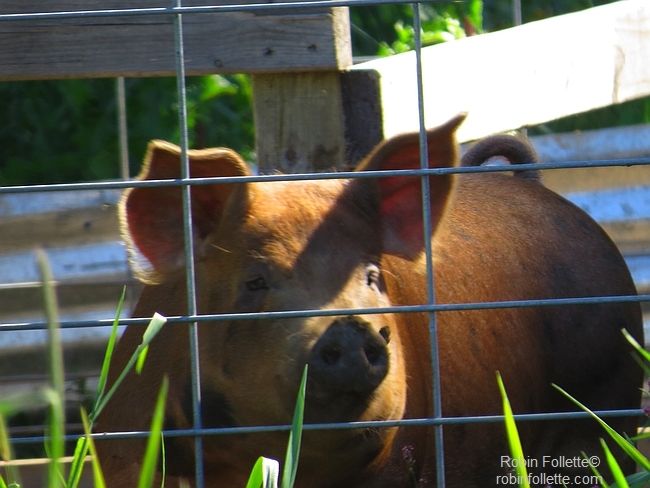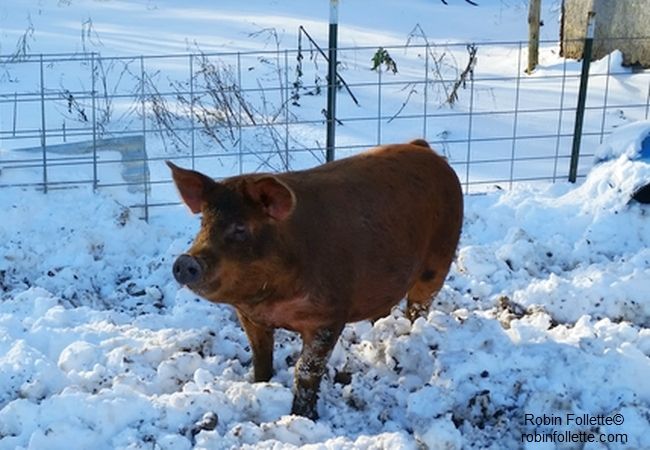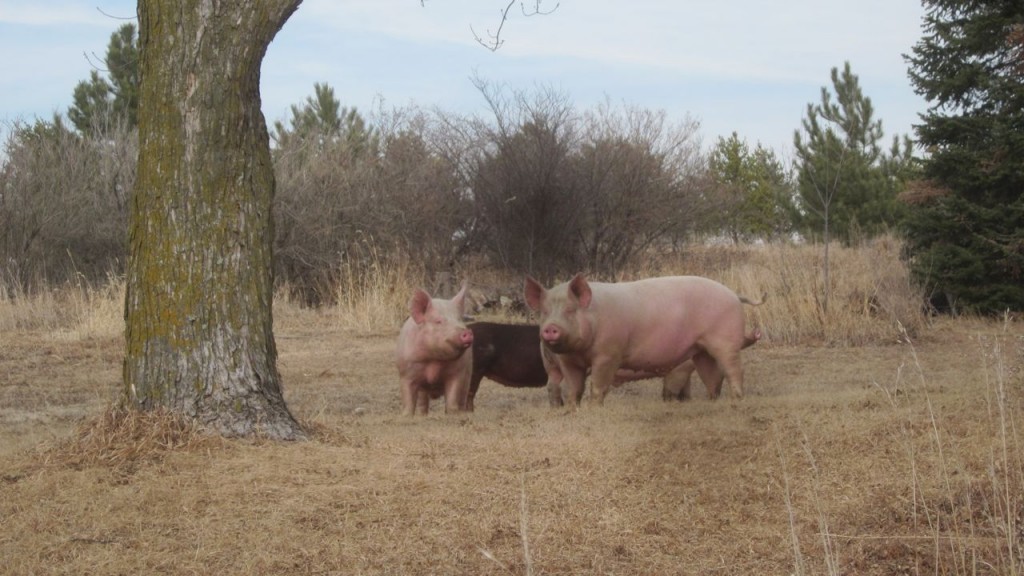Makin’ your own Bacon: raising a pig in the backyard isn’t that hard
I’ve been interested in raising a pig (or two) for a year (or two). I have yet to get my good husband onboard, but that doesn’t keep me from studying the matter, and sharing anything I learn with you, my Gentle Readers. (And him. 😉 )
I do all this just for you, you know. 🙂 And anyway, I think he’s weakening . . . (By the way, I guess I could blame this desire on my mother, who kept the pig “Flower” in our sideyard for several months when I was a young, impressionable young girl.) Oh! And I’ll try to keep my nose out of this post, but if the desire to chime in becomes overpowering, I’ll switch to this color. See? Robin’s voice. My voice. Got it?
My friend, writer and blogger Robin (who blogs over here), has experience in raising pigs. She agreed to write an introduction to raising your own pigs for me, so without further ado, I present to you . . .
“Preparing to Raise Meat Pigs”
By Robin Follette
Keeping pigs, even if only from spring to fall, takes some planning and work. To keep this as simple and enjoyable as possible, the work should begin well before you bring your piglets home.
Pasture or Pen
Pigs are grazers, browsers and rooters wrapped into one. If you have good quality pasture you should plan on one-quarter to one-half acre per animal. The larger your pigs will be allowed to grow and the longer you’ll keep them bumps the size of the pasture up.
You can use the space where your future garden will be located as the pasture. The pigs will eventually clear the spot of grass and some weeds, turn the soil over roughly, and root up rocks. Keep the timing of the garden and parasites pigs pass on in feces in mind when you’re making your plans.
Fencing
Pigs are curious creatures that will roam as far as allowed. Good fencing is a must. Hog panels are sturdy when mounted on solid fence posts, and they’re portable. You can add a 16’ x 16’ area by adding three panels to the end of a pasture and removing what was the end. This keeps the pigs contained while moving the pasture.
If you don’t have a place for a permanent pasture, you can use step-in fence posts. Attach the panels and string a hot wire six inches from the inside edge of the hog panels. The piglets will touch the hot wire. They will scream. They will race around like confused thoroughbreds. They will stop and they will calm down.
Electro net is another portable, temporary option. The piglets will touch it. String it tight so that when they bolt they don’t become tangled. Be there, near the switch, to turn the power off if necessary. Pigs are intelligent. They seldom repeat mistakes.

(photo Credit Robin Follette)
Shelter
Since your pigs are being raised for meat, we’ll assume you won’t be keeping them over the winter. A three-sided shelter that keeps hard rain and hot sun, and serves as a wind break, is plenty. Locate the shelter on the high side of the pasture so that rain and urine drain. If you can’t keep the pigs on a high spot you can build a wooden platform. Raise it eight to 12 inches off the ground and leave a one-half inch gap between boards.
While the piglets are still young, and if the weather is chilly, give them plenty of bedding to keep them warm and comfortable. I use hay. The pigs will eat it fresh off the bale and use the rest for bedding. If they’re being kept in a pen, it’s a good idea to add fresh bedding daily to keep them clean.
If you decide to keep your pigs over the winter, as sometimes happens (usually with sows), you’ll need at least a 10’ x 10’ stall. Six foot long pigs need room to turn around.
Bathroom
Pigs are clean animals. Other than wallowing in mud to stay cool and insect free, pigs want to be clean. They’ll choose a spot for their bathroom and use it until it becomes too dirty. Shovel the manure and wet bedding every day or so to eliminate muck and odor. If a pig smells bad it’s most likely because its bathroom is dirty.
Visit the Farmer Ahead of Time
My reliable farmers had a series of mishaps last year. Piglets are hard to find in this area. Raising pork is popular and piglets are in demand. Friends of ours found a farmer near their home. His home and barn are stunningly beautiful, at least on the outside. The inside of the barn was relatively clean. The pigpen was nothing less than filthy. The piglets were unhandled and wild. He caught the piglets and put them in our crate while we watched. I had two choices: accept these piglets or go without for the year. Reluctantly, we loaded the smelly pigs into the back of the truck, strapped the crate down, and brought them home. He and I will not do business again.
Are the pigs clean, calm, used to people? Ask questions. If you have questions after you bring the piglets home will the farmer be available to answer? The answer to my question was “no.” This family does not have a telephone. Ask, “What do I need to know that I didn’t ask you about?”
(I love this suggestion, by the way–Amy)
One of the most important questions you can ask your farmers is “Who is your vet?” You probably won’t need a vet. Pigs are generally healthy and haven’t been so improperly bred that they have genetic problems. Accidents happen and sometimes animals do get sick. Talk with a vet before you get your piglets. Waiting until you need a vet can lead to disaster. Vets are busy. Establish a relationship with the vet ahead of time. Ask questions, and don’t forget to ask, “Is there anything I didn’t know I should ask you?”

“Contemplative Red Pig in Snow” (photo credit Robin Follette)
Food
Ideally, you have enough excellent quality pasture to keep your pigs on. Realistically, most of us don’t. You have a lot of options for food.
- Commercial pellets. If you can build a bin to have them delivered in bulk rather than purchasing them in 50 pound bags you’ll save money IF you’re going to raise pigs more than one year.
- Food scraps: Restaurants, schools and stores might be willing to save their food scraps for you. That can include outdated milk and day old pastries and bread. Pass on meat. Outdated meat can be a health hazard waiting to happen.
- Hay: When I was a kid we sang “Hay is for horses, goats and cows. Pigs don’t eat it cuz they don’t know how.” That’s not true. Pigs do eat hay. Hay is, after all, grass, and is a good addition to a balanced diet.
- Garden Scraps: Overgrown zucchini and cucumbers, pumpkins, corn stalks and spent plants are great pig food. You can turn your garden weeds into bacon by throwing them into the pen.
- Fruit. We rake up our tree fruits to avoid yellow jackets and hornets gathering, and feed the fruit to the pigs. They can fatten up fast on bushels of dropped apples.
Feed the pigs in a bin raised off the ground. It will help keep them from stepping on and in the food. Make sure it’s secure enough that they can’t turn it into a toy but not so secure that cleaning it is a big job.
I made a mistake feeding our pigs, then hogs, last year. The butcher got sick and delayed our appointment for slaughter and butchering. He had to keep deer season open. Our hogs were not picked up until December 1. By then we had two feet of snow on the ground and the overnight temperature was dropping below 0°. I overfed the hogs with the thought that it would keep them warm. It made them fat, fat, fat. I should have spent the extra money on straw or hay. It would have saved us money in butchering since we paid by the pound, and the hogs probably would have been warmer. Their hanging weights at eight months were 240 and 260 pounds.

These lost pigs showed up at our place one afternoon. We never did find the owners. Everybody in our area denied that they were theirs. We should have just penned them up, but we were in and out all day long, and they eventually wandered off. Opportunity and free bacon missed!! 😉 –Amy
Water
Water is half a wallow. Water bins on the ground become muddied with dirt off the snout. If it’s big enough, the pigs will lay on or in the container. Be prepared to clean a bin several times a day to keep water clean.
Pigs don’t sweat. They need a wallow so they can cool down. They also need mud as a sunscreen and insect repellent.
Automatic waterers provide a nipple/spout for access, are anchored above ground, and stay clean. Keep the hose/pipe out of hot sun to avoid burning the pigs, causing dehydration. I will use this method next time we raise pigs. Going into the pasture with small wild piglets is one thing. Going in with 200-pound still slightly wild, very pushy pigs is another.
(Note from Amy: I got lost online, reading about automatic pig waterers. There are so many different things you can make, to make keeping fresh water for your pigs an easier process.)
Stimulation
Pigs are intelligent. They need to be active. A depressed pig will not thrive. Give them a wallow to play in, balls, grain sacks (remove string), food they have to work at like whole corns stalks, large pumpkins, and other things to do. If they aren’t given something to do they’ll find something to do and it might be destructive. A scratching post for itchy skin will soothe the itch and give them something to do.
Are you ready for your pigs? Good luck and happy bacon!
Thank you, Robin, for this thorough and fascinating primer on raising pigs. Gentle Readers, if you have any questions, I’m sure that Robin would entertain them in the comments below. And be sure to check out Robin’s blog here. It’s quite interesting, covering daily life with a variety of critters, hunting, fishing, gardening, and is one of my favorite daily reads.
Robin Follette is an outdoorswoman and homesteader. She lives in the woods of northeastern Maine with her husband Steve. They hunt, fish, garden and gather almost all of their food.
Be sure to visit Robin’s website right here!
- Juicing for Idiots (and backwards country types–like you-know-who . . .)
- Interview with my friend Gene



Thank you for having me! I appreciate being able to share info!
Very complete guide to raising pigs! Of course, you’ll be getting this all day, so I’ll be the first: How do you not get attached??? Not sure I’d be able to do it . . .
Kimberly
http://FiftyJewels.com
It’s hard to not get attached at least a little. These were not loveable pigs when they arrived. I spent months calming them down and instilling trust. On the day they went to slaughter I walked into the pen with them for the first time since they were tiny, walked them to the livestock trailer, and loaded them.
The first time we sent livestock to slaughter I sat on the back porch and cried for two hours. I’d all but turned him into a pet. If he hadn’t been with his protective mother he would have been led around by a leash. That was the last time I made that mistake.
Now, everything we raise for meat is thought of a little different than the others. They are meat from the start. They are scratched, hand fed treats, treated with respect and over all have a great life. I tend to them morning and night, look out to the pasture to be sure they’re where they need, and that’s it. I don’t spend the amount of time with them I did the dairy goats, horses, pet pigs, breeding stock poultry, etc. There’s a divide in my mind. They are food. We have two dogs, a cat and a bunny for pets.
I hope that makes sense!
Robin
Raising pigs has never been on my agenda but you make a compelling argument! Now- if you ever raise bees….
I’m considering bees. We’re having another cold, wet spring. I walked around this morning to look at the fruit trees and was disappointed. The trees weren’t buzzing when they were blossoming and it doesn’t look like pollination was very good. I looked into it a bit in April and found out I can get set up with one hive, bees and all of the clothing and equipment for about $500. Maybe next year!
I had no idea that pigs are clean animals when it comes to their bathroom habits! You learn something new everyday… for whatever reason that is just not what I would have guessed! This is such a detailed post, great work! Thanks for joining the Link-It To Me Link Up Party, hope you will party with me again next week 🙂
Thank you Chantal. I’ll try to do that!